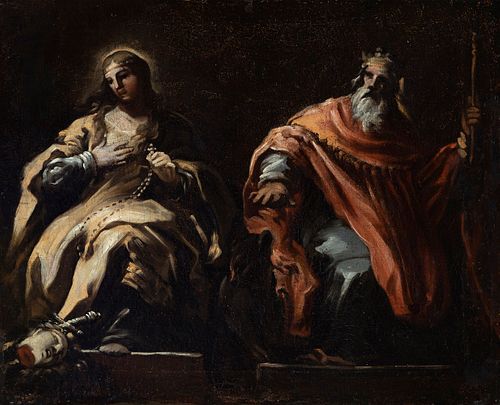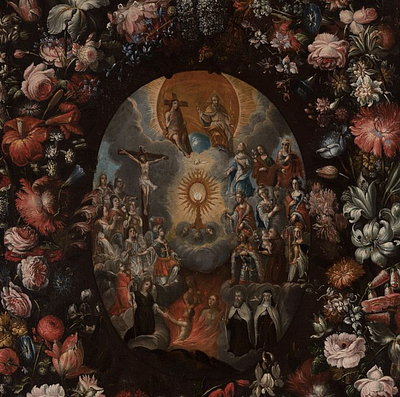Italian school of the XVIII century, workshop of LUCA GIORDANO (Naples, 1634 - 1705). "Saint Catherine and King David". Oil on canvas
Lot 132
About Seller
Setdart Auction House
Carrer Aragó 346
Barcelona
Spain
Setdart Subastas was born in 2004 and is currently the first online art auction in Spain with solidity, prestige and reliability guaranteed by our more than 60,000 users. Setdart has a young, dynamic and enterprising team ready to successfully manage the purchase and sale of art works through custom...Read more
Estimate:
EUR€12,000 - EUR€14,000
$12,903.23 - $15,053.76
Absentee vs Live bid
Two ways to bid:
- Leave a max absentee bid and the platform will bid on your behalf up to your maximum bid during the live auction.
- Bid live during the auction and your bids will be submitted real-time to the auctioneer.
Bid Increments
| Price | Bid Increment |
|---|---|
| EUR€0 | EUR€10 |
| EUR€200 | EUR€25 |
| EUR€500 | EUR€50 |
| EUR€1,000 | EUR€100 |
| EUR€3,000 | EUR€200 |
| EUR€5,000 | EUR€500 |
| EUR€10,000 | EUR€1,000 |
| EUR€20,000 | EUR€2,000 |
| EUR€50,000 | EUR€5,000 |
About Auction
By Setdart Auction House
Jul 14, 2021
Set Reminder
2021-07-14 06:30:00
2021-07-14 06:30:00
America/New_York
Bidsquare
Bidsquare : OLD MASTERS
https://www.bidsquare.com/auctions/setdart-auction-house/old-masters-7202
Setdart Auction House sofia@setdart.com
Setdart Auction House sofia@setdart.com
- Lot Description
Italian school of the XVIII century, workshop of LUCA GIORDANO (Naples, 1634 - 1705). "Saint Catherine and King David". Oil on canvas Size: 44 x 54 cm. Through a fast and precise brushstroke the author of this work configures a scene, sober and regal but full of dramatism. Which is configured thanks to the monumentality of both protagonists. The author uses a clear and concise composition, as a frieze and symmetrical, in such a way that facilitates the viewer's reading of it, getting him to focus his attention on the iconographic attributes of each of the characters. In the left zone, a woman, of large dimensions, holds a rosary in her hands and takes her right hand to her chest, while at her feet lies a decapitated head. So it can be identified as Santa Catalina. In the case of the male character, the presence of the Scepter and the animal on the left are reminiscent of the attributes of King Solomon. This work is inscribed within the aesthetic patterns of the Spanish school, especially close to the work of Luca Giordano, the most prominent Neapolitan painter of the late seventeenth century, and one of the main representatives of the late Italian Baroque.painter and engraver, known in Spain as Lucas Jordan, Giordano enjoyed great popularity during his lifetime, both in his native Italy and in our country. However, after his death his work was often criticized for its speed of execution, opposed to the Greco-Latin aesthetics. It is believed that he was formed in the environment of Ribera, whose style he followed at first. However, he soon traveled to Rome and Venice, where he studied Veronese, whose influence has been felt ever since in his work. This trip was key to the maturation of his style, as well as the influences of other artists such as Mattia Preti, Rubens, Bernini and, above all, Pietro da Cortona. At the end of the 1670s Giordano began his great mural decorations (Montecassino and San Gregorio Armeno in Naples), which were followed from 1682 by other projects, including the mural paintings in the gallery and library of the Palazzo Medici Ricardi in Florence. In 1692 he was called to Madrid to carry out mural works in the monastery of El Escorial, where he worked from 1692 to 1694. Later he also painted the office and bedroom of Charles II in the Royal Palace of Aranjuez, and after these he undertook the paintings of the Casón del Buen Retiro (ca. 1697), the sacristy of the cathedral of Toledo (1698), the royal chapel of the Alcázar and San Antonio de los Portugueses (1699). However, royal commissions ceased with the arrival of Philip V in 1701 and the beginning of the War of Succession, so Giordano returned to Naples in 1702, although from there he continued to send paintings to Spain. Today Giordano's works are kept in the most important art galleries around the world, including the Prado Museum, the Hermitage in St. Petersburg, the Louvre in Paris, the Kunsthistorisches in Vienna, the Metropolitan in New York and the National Gallery in London.
- Shipping Info
-
In-house shipping available. Please inquire at admin@setdart.com.
-
- Buyer's Premium



 EUR
EUR CAD
CAD AUD
AUD GBP
GBP MXN
MXN HKD
HKD CNY
CNY MYR
MYR SEK
SEK SGD
SGD CHF
CHF THB
THB















